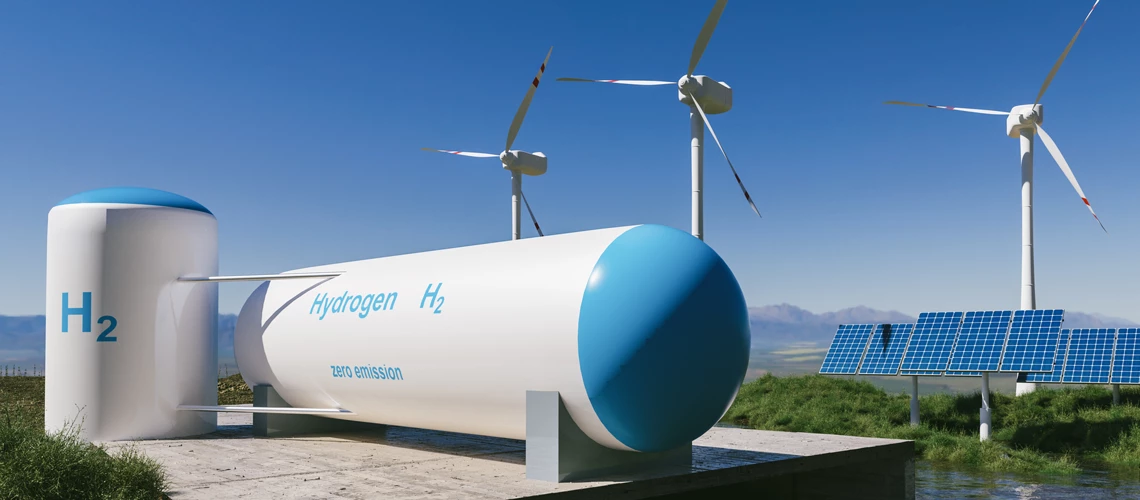 Low-carbon hydrogen is a unique fuel with a high potential to address climate change and development.
Low-carbon hydrogen is a unique fuel with a high potential to address climate change and development.
Low-carbon hydrogen is a unique fuel with a high potential to address climate change and development. It can help accelerate decarbonization of hard-to-abate sectors such as heavy industry and global transport, while also promoting sustainable growth in the developing world. Low- and middle-income countries are emerging as leaders to produce and export this unique fuel that can expand energy and food security, create jobs, and earn revenue while helping to mitigate the impacts of climate change.
Here’s how.
The most common element in the universe, hydrogen can be produced in multiple ways. One of the most promising methods to produce low-carbon hydrogen is to split it from water (H2O) using electricity, a process known as electrolysis. Many developing countries have abundant solar and wind resources and existing scalable renewable energy infrastructure to support electrolysis production. Others have legacy infrastructure that can be repurposed for low-carbon hydrogen production and transport.
There are multiple uses for this resource. Low-carbon hydrogen can be used in heavy industries such as steel manufacturing, commercial airliners, and cargo ships that currently rely on fossil fuels and accounted for nearly 24% of global greenhouse gas emissions in 2019. Finally, hydrogen can be used to produce ammonia, a key component of fertilizer and a store of low-carbon energy that can be transported worldwide.
"Estimates suggest that hydrogen use would need to grow sixfold to support the global energy transition, eventually accounting for 10% of total energy consumption by 2050."
The price of low-carbon hydrogen is falling fast and is estimated to reach USD 1.3 per kg by 2030. This trajectory is creating high expectations from governments, investors and businesses that are working to meet the growing demand. A hydrogen-powered passenger plane lifted off in 2020 and earlier this year a Canadian steel plant successfully operated using low-carbon hydrogen in a test run. About thirty countries have developed, or are in the process of developing, hydrogen plans central to their decarbonization strategies. In the private sector, more than USD 300 billion in hydrogen investments are earmarked through 2030.
For low- and middle-income countries, low-carbon hydrogen has the potential to grow export revenue, generate energy capacity to meet local needs, and decarbonize domestic manufacturing. It also creates a value-added export sector that generates jobs for skilled labor.
Some low- and middle-income countries are already signing memorandums of understanding (MOUs) with potential clients. For example, a 2021 agreement between Namibia and the Netherlands calls for the creation of a hydrogen supply chain between the two countries. Developing countries are also making deals with each other - earlier this year Egypt and India signed an agreement to build a low-carbon hydrogen facility in the Suez Economic Zone.
The World Bank Group is working with developing countries around the globe to advance their low-carbon hydrogen plans. Chile, abundant in solar and wind resources, is aiming to produce the world’s cheapest low-carbon hydrogen by 2030, positioning itself among the top three exporters by 2040. Morocco is working to develop large low-carbon hydrogen projects that will attract private investors, while Brazil aims for the State of Ceará to become a major hydrogen fueling hub.
Estimates suggest that hydrogen use would need to grow sixfold to support the global energy transition, eventually accounting for 10% of total energy consumption by 2050.
Sounds daunting, but we’ve been down this road before.
Solar and wind power were prohibitively expensive a decade ago, but have now joined renewable hydropower as the cheapest forms of energy – with onshore wind power averaging 0.03 per kilowatt hour. With 90% growth since 2000 in wind and solar, renewables now supply almost a quarter of the world’s electricity needs. That same spirit of global innovation and cooperation can steer the transition to low-carbon hydrogen.
To accelerate this transition, we all need to move to action.
First, we need governments to adopt policies that promote production of low-carbon hydrogen, encourage demand visibility, and support end-users to repurpose their infrastructure. International organizations, such as the World Bank Group, can provide technical assistance and concessional financing to build capacity and mitigate risks to enable the private sector to engage in transformational projects.
Public and private support is also essential to jumpstart innovations in the production, transport, and use of low-carbon hydrogen in ways that enhance resilience, create jobs, and reduce greenhouse gas emissions, while managing social and environmental impacts.
At the World Bank Group, we are seeing strong demand from client countries for assistance with developing hydrogen programs. To respond to this demand, the World Bank Group will soon launch a new hydrogen partnership, hosted and managed by the Energy Sector Management Assistance Program (ESMAP), which will bring together best practices on hydrogen relevant to clients and provide advice and capacity building on policy and project development. The partnership will also catalyze significant financing for hydrogen investments, with substantial World Bank Group commitments, that in turn are likely to attract an even greater amount in private financing.
The hydrogen energy revolution emerging in the developing world needs global support for the benefit of all. Low- and middle-income countries have the opportunity to forge a new path and make the future of energy more secure, cleaner and healthier for future generations.


Join the Conversation